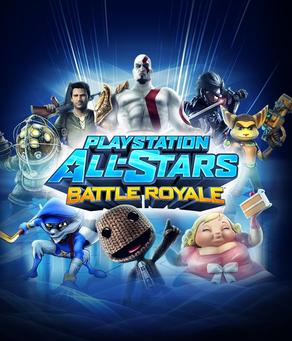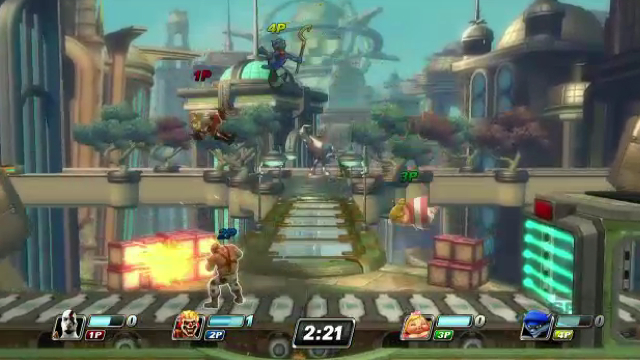Starting now, I’ll be making an effort to update the Looking Glass once a week!

Super Smash Brothers came out of nowhere and instantly became its own genre. The ‘mascot brawler’ spawned sequel after sequel, with increasingly ambitious story modes (…until recently) and increasingly packed character rosters. And if you think it’s strange that I began a review of a game that isn’t Smash Bros. with the words “Super Smash Brothers” – well, All-Stars makes no bones about the fact that it’s a me-too mascot brawler, riding on the coattails of Nintendo’s Frankensteined fighter like so many kart racers in the wake of Mario Kart 64 in the late 90s.
The thing is, though, Nintendo has – let’s call it a “type”: Nintendo has a “type”. Fun, colourful characters are generally the order of the day in their star franchises, be it the misproportioned plumber brothers or the life-size pocket monsters or the anthropomorphic animal pilots. Even Samus, hailing from what is Nintendo’s far-and-away most serious and “adult” first-party property, boasts colourful armour that helps her fit in with the rest of the gang. So even when a gorilla clad in a monogrammed tie is fighting a big fire-breathing spiked turtle on top of a starship, it all feels cohesive.
Sony, on the other hand…I just don’t know about this, you guys. It’s certainly not cohesive aesthetically; something just feels intrinsically disjointed here from a conceptual standpoint, and I know that sounds amorphous, but you’ll see what I mean the first time you see Kratos putting the smack down on Sly Cooper or Fat Princess laying out Isaac Clarke. It feels like there was an underlying assumption here that if it worked for Nintendo, then it must work for Sony.

The pieces are in place, but it’s like they’ve cloned the body and not the soul. (Gosh, even my game reviews use speculative-fiction talk.) It’s nice to see that they’ve made the effort to even include stages from games whose characters didn’t make the cut, such as a wartorn wasteland from the Resistance titles, though it doesn’t alleviate the lack of cohesion.
And in case my argument about aesthetic cohesion still feels too ephemeral, here’s another example that also happens to include Kratos: Mortal Kombat 9. The PS3 version of that game features Kratos as a bonus fighter, and the reason that feels cohesive is because Mortal Kombat and God Of War are already two peas in a pod: both series draw heavily on world mythology for their imagery (Greek in God Of War, and a pan-Asian portmanteau in Mortal Kombat), and both involve hyper-violence with oodles of blood and gore, and Kratos’s art style is already similar to the male warriors in Mortal Kombat anyway.
Cut to an image from All-Stars of Kratos beating up, like, Sly Cooper or something, and – am I making sense yet, guys?

And if you’re going to do a game where the whole point is wish-fulfillment and fanservice, you’ve gotta go all the way, so I’ll ask: where in the nine hells are Crash Bandicoot and Spyro The Dragon, two mascot-esque characters who pretty much defined the Playstation in my childhood? Granted, it may be a careful-what-you-wish-for scenario, given that Spyro of late looks like life smacked him repeatedly with the screw-you stick (Can you blame him, though? Those Skylandy things basically evicted him from his own series’ limelight), but even so, no Crash? I know he’s multiplatform now, but you know, so’s the Big Daddy, a character who even landed a spot on the cover art. The dragoncoot weren’t even invited via DLC; in a game where the whole point is nostalgic wish-fulfillment, that’s like if Smash hadn’t included Donkey Kong or Link. Or, hell, given how far to the Sony forefront that he was pushed in the late 90s, not having Crash is like if Smash hadn’t included Mario.

And – guys, that’s my line in the sand right there. Considering Nintendo can get Sonic, Mega Man and Pac-Man in Smash Brothers, all talk about copyrights and licensing goes right out the window, because it’s obvious that this being the case, Sony didn’t try hard enough. I’m very, very tempted to turn the lack of these mascots into an instant-fail condition, given the kind of game we’re talking about here.
Then there’s the elephant in the corner – the thing that, once I say it, will make me look like a Nintendo fanboy even though that’s not true at all. So here goes: maybe part of the reason this game feels so dissatisfying to experience, compared to Smash, is simply that Nintendo has a much stronger and more distinct first-party roster than Sony does. There’s a disconnect between the gr1tty, h4rd ‘serious’ characters and the more floofy, animated characters. And what the Christ is the cake-chugging Fat Princess anyway? Maybe there’s some kind of subtext or satirical angle in the game she’s from, but the way it comes off here is as a walking fat-joke. I don’t want to see that, and why would you? And to me, that character’s inclusion shows that they were really reaching for appropriate ‘mascot characters’ to fill the game with. It’s just…unpleasant, and I find myself hoping pre-fight that the CPU won’t bring her in on this match.
In fact, maybe the reason the ‘mascot brawler’ is a genre pretty much defined exclusively by Smash is because Nintendo’s uniquely single-minded focus on first-party franchises has given them a razor-honed selection of themes and characters to distill in these games. It’s come to their detriment when third-party developers found the Nintendo 64 or Gamecube hardware too different to develop for, and thus flocked to making third-party games for Sony and Microsoft instead, but in the Smash series it all comes together. In that way, it almost feels like Smash Bros. is Nintendo cashing in the chips that it had accumulated while outside developers were passing them up for the greener pastures (Developmentally speaking) of Sony and Microsoft consoles.
After all, I think a Microsoft-themed brawler would meet much the same fate as this game: beyond Master Chief and Marcus Fenix, what really distinct, exclusive mascot-type characters would be in a game like that? Remember when Blinx was a thing? No? The most distinct characters I can see in a game like that would be the characters that Microsoft pilfered from Nintendo anyway during the Rare deal, like Fulgore, Banjo/Kazooie and Joanna Dark.
So now we’re over ten paragraphs deep and haven’t touched on the actual gameplay, which in most contexts would be burying the lead so deep it technically counts as archaeology. But to be honest, the gameplay was secondary in the minds of its creators; they simply looked at the runaway success of Smash Bros., decided to copy it part-and-parcel, and put their product out there without really giving critical thought to why Smash Bros. received such acclaim to begin with. Maker help me, but I’m going to have to pull the art-verus-artless card: this is a product moreso than a piece of art, and it owes its existence to a(n improper) reading of market trends and a desire to follow instead of lead. In terms of Wayne Gretzky’s immortal quotation, they went where the puck was instead of where it was going to be.
But, to be honest, it’s fun to play. It’s got the same frenetic action as Smash, and the same kinds of multi-tiered levels for variety. Much like the series that inspired it, it’s very easy to just pick up and play, no matter whether you’re hailing from God Of War’s cinematic vision of ancient Greece or from Sly Cooper’s pulp-crime comic-book world.
So it’s a fun game: really, mascot brawlers make no bones about the fact that they’re the digital equivalent of all those times in your childhood when you made your Wolverine action figure fight your Megatron, and this game succeeds at bringing out that inner child in fleeting, but glorious spurts. Come on, there’s something inherently satisfying about matching thieves Nathan Drake and Sly Cooper against each other, or pitting Isaac Clarke against a Big Daddy. It’s pure action-figure fight fantasy, and doesn’t pretend to be anything more.

The thing is, if you’re going to go this route when developing a game, then you can’t just stand in the shadow of the thing that inspired you. You have to be better than what’s on display here: you have to make the extra effort and get those characters people want to see. That this game doesn’t have Crash or Spyro wouldn’t be such a failure if the whole point wasn’t to capitalize on Playstation nostalgia. As it stands, I’ve made my decision: it’s not forgivable in a game like this. Imagine if they made (Oh I don’t know) a Doctor Who fighter, and didn’t include Four, Ten or Eleven (typically the fanbase’s top three Doctors). Fans would be livid.
Just…if you’re going to rip something off, I want to see you saying, “Alright, you had your chance, now sit down – this is how it’s done.” Not just meekly standing in line giving come-hither glances at fans of the thing you’re trying to mimic.
Here’s a great example – Crash Team Racing. This came out during the me-too kart racer era that followed Mario Kart 64, but this game made Mario Kart sit down and watch how it’s done: CTR had everything that Mario Kart had – colourful characters and tracks, fluid controls and fun items, a cool combative multiplayer for people who hate their friends – but also jacked up the player’s investment in the game with a full-fledged story mode including different ‘worlds’ and hub levels, and even fleshed-out boss battles.
And the icing on the cake is that the difficulty balance made it a more fun game than Mario Kart for me, thanks to MK’s continual insistence on punishing good players for doing well and trying to make races as close as possible every single time.

Crash Team Racing knew what it was, and what it had to do in order to stand out. It knew it had to go the extra mile to compete with the thing that had inspired it, and it did that mile in a stylish power-slide.
But Playstation All-Stars only wants us to think it went the distance. It has its moments, and it’s fun to play, and for that I’ll give it a pass. If you can find it for real cheap, go get it, sure. But they’re directly trying to compete with the same franchise that in 2008 gave us The Subspace Emissary, and they didn’t bring their A-game to the table in terms of ambition. I try to look at all entertainment media in two distinct ways at the same time: in a vacuum, and in how it interacts with the art around it. In a vacuum, this game would be okay if not for some glaring omissions I’ve already ridden into the ground. But in terms of how it interacts with the franchise it so desperately wants to be…
It thinks it’s Super, but it just got Smashed, bro.
Two sets of nostalgia goggles out of four, because I can’t bring myself to fail a game that is earnestly fun to play once in a while.
